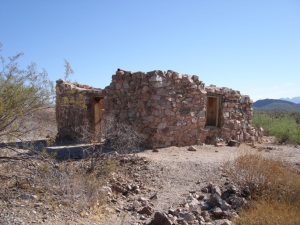by Ken Shroyer
In the late nineteenth century, many men sought their fortunes mining for gold and silver in or near what is now Organ Pipe Cactus National Monument. In this long and colorful history, the story of the Victoria Mine stands out.
Beginning in the 1890s, the Victoria Mine was the center of this sporadic mining of gold and silver in the Organ Pipe Cactus National Monument region. While the most extensive efforts occurred between the 1890s and the 1910s, periodic mining efforts took place through 1976, operating under a special use permit from the National Park Service.[1] With the Organ Pipe Cactus National Monument being designated by the park service as a wilderness area, all mining ceased after 1976.
The early development of the Victoria Mine was politically tied to the Ortega hacienda at Santo Domingo, Mexico.[2] Cipriano Ortega, a Mexican national and businessman acquired the mine in 1880. It is estimated that $80,000 of silver ore was mined under  Ortega’s operations through 1899.[3] During Ortega’s ownership the mine was known as the “La Americana” mine. Milul Levey, an American businessman with ties to Ortega, purchased the mine in 1899. Levey would rename the mine “La Victoria” in honor of Victoria Leon, the wife of Levey’s storekeeper.[4] Levey and subsequent owners, however, extracted only another $40,000 of silver ore, partly because of the high water table of the area and the technical problems associated with sinking the shaft below it.[5]
Ortega’s operations through 1899.[3] During Ortega’s ownership the mine was known as the “La Americana” mine. Milul Levey, an American businessman with ties to Ortega, purchased the mine in 1899. Levey would rename the mine “La Victoria” in honor of Victoria Leon, the wife of Levey’s storekeeper.[4] Levey and subsequent owners, however, extracted only another $40,000 of silver ore, partly because of the high water table of the area and the technical problems associated with sinking the shaft below it.[5]
Even after the prohibition on mining, the Victoria Mine and its colorful history did not simply vanish. In 1978, Victoria Mine was listed on the National Register of Historic Places as one of the oldest prospecting sites in southwest Arizona.[6] Although it originally started out as a Mexican venture, it became a symbol of one of the first American enterprises to penetrate this part of the inhospitable Sonoran Desert.[7] The Victoria Mine’s total output represents a small percentage of Arizona’s total gold and silver output. Yet its significance rests in its effect on the region’s early settlement and the site’s potential for the artifacts, objects, and structures left over from the mine’s productive years to yield information about the desert mining era.
To visit this historic landmark, one only needs to lace up some hiking boots and trek 2.2 miles on the park’s Victoria Mine Trail. The trail starts at the far side of the national monument campground and can be reached by a short road south of the visitor center.[8]
Further Readings
For more information on the Organ Pipe National Monument, a good place to start is the National Park Service’s website for the Organ Pipe National Monument, http://www.nps.gov/orpi/index.htm.
For further information on the trail itself, the American Southwest website http://www.americansouthwest.net/arizona/organ_pipe/victoria-mine-trail.html gives a nice detailed view of the trail and what to expect along the way.
[1] National Park Service “Organ Pipe National Monument: Monument Timeline.” National Park Service…http://www.nps.gov/orpi/historyculture/monument-timeline.htm (accessed February 13, 2012).
[2] National Park Service.Cultural Landscape Survey 2010: Organ Pipe Cactus National Monument. http://www.cefns.nau.edu/Orgs/CPCESU/current/documents/ASU-45FinalReport.pdf (accessed April 12, 2012).
[3] minedat.org. “Victoria Mine (La Americana Mine; Ortega Mine).”http://www.mindat.org/loc-36160.html (accessed February 13, 2012).
[4] Bennett, Peter S, and Michael R. Kunzmann. A History of the Quitobaquito Resource Management Area, Organ Pipe Cactus National Monument, Arizona. Tucson: Cooperative National Park Resources Studies Unit, School of Renewable Natural Resources, University of Arizona, (1989) 29.
[5] National Park Service.“Victoria Mine Stone Building.” National Park Service: List of Classic Structures. http://www.nps.gov/…/Victoria%20Mine%20Stone%20Building.pdf (accessed February 13, 2012).
[6]National Park Service. “Victoria Mine Stone Building.” National Park Service: List of Classic Structures. http://www.nps.gov/…/Victoria%20Mine%20Stone%20Building.pdf (accessed February 13, 2012).
[7] National Park Service. “Victoria Mine Stone Building.” National Park Service: List of Classic Structures. http://www.nps.gov/…/Victoria%20Mine%20Stone%20Building.pdf (accessed February 13, 2012).
[8]The American Southwest. “Victoria Mine Trail, Organ Pipe Cactus National Monument.” http://www.americansouthwest.net/arizona/organ_pipe/victoria-mine-trail.html. (accessed February 13, 2012).
